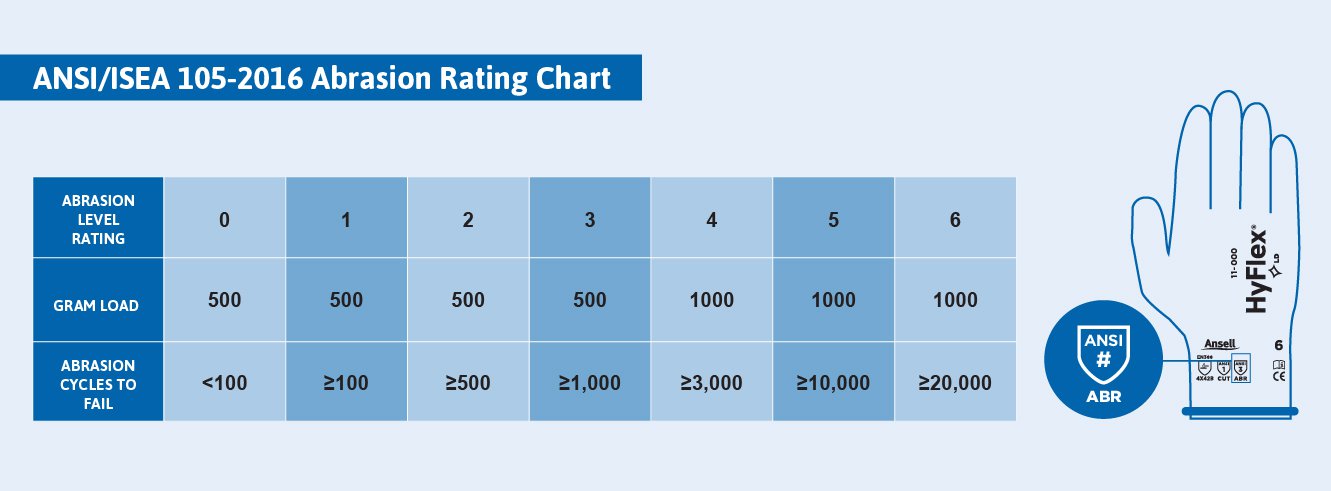The term "abrasion" refers to the process of scraping or wearing away by means of friction. Workers face a multitude of hazards in the industrial workplace, many of which are associated with the risk of abrasion to the hands when handling various tools and materials. Lack of proper hand PPE can leave workers vulnerable to injuries such as irritation from repetitive rubbing and scraping of the skin. Abrasion resistant gloves provide a barrier against the wear and tear of abrasive environments and materials using protective layers of synthetic fabrics and deliver the comfort, performance, and protection needed to keep workers safe throughout their workday.
What is the ANSI/ISEA 105-2016 Abrasion Standard?
ANSI/ISEA 105-2016 is a North American standard updated in 2016 measuring hand protection across a variety of Industrial risks. Set by the American National Standards Institute (ANSI) and by the International Safety Equipment Association (ISEA), the ANSI/ISEA 105-2016 standard measures abrasion resistance for Industrial work gloves on a seven-level scale of 0 to 6.
The standard is based on ASTM D2289-10 and ASTM D3884-09 abrasion testing methods which measure the number of cycles required for an abrasion wheel to break down the glove material. Levels 0 to 3 are measured with a 500-gram load on the abrasion wheel while levels 4 to 6 are measured with a 1,000-gram load. The glove material is then mounted and abraded by the spinning wheel until the material is worn through, creating a hole, under the corresponding weight. The greater the number of cycles it takes to break the material down, the higher the abrasion rating. The results are shown in the new ANSI abrasion standard rating chart below:
What is the EN 388:2016 Abrasion Standard?
Also updated in 2016, the EN 388:2016 standard is set up for European regions and also taken over by other regions such as Asia, Australia & New Zealand and South American regions as part of their local standards. The EN 388 shield pictogram reports up to 5 different mechanical performance measures with the first position (“a”) representing abrasion resistance on a scale of 1-to-4. Unlike the ANSI standard, the EN 388:2016 standard leverages a Martindale abrasion machine to measure the abrasiveness of each glove. A piece of the glove's palm is cut and placed before a wheel covered in abrasive paper. The glove material is then abraded until a hole is present. The test is performed a total of four times. The test results demonstrate that the lowest number of cycles before creating a hole between the four trials becomes the glove's abrasion rating. Like the ANSI Standard, the greater the number of cycles it takes to break down the safety material, the greater the abrasion safety rating. Shown below are the EN 388:2016 abrasion standard ratings:
Are the ANSI/ISEA 105-2016 Standard and EN 388:2016 Abrasion Standard Equal?
In short, no. Each standard indeed represents protection against the same mechanical risks. However, it is important to note that the standards are not equivalent (i.e. ANSI abrasion level 3 is not equivalent to EN abrasion level 3). The main differences lie in the number of cycles to fail per level, testing methods, and the number of abrasion levels within each standard.
Best in Class Protection
The best protective solutions are designed for defined tasks. Abrasion-resistant gloves reduce on-the-job injury and deliver the comfort, performance, and protection needed to keep workers safe and productive throughout the day. Explore our trusted HyFlex® range of high-performance abrasion resistant solutions that include Ansell’s FORTIX™ Abrasion Resistance Technology — a proprietary technology that applies a thin, resilient, and breathable nitrile foam coating to knitted gloves, providing greater flexibility, enhanced breathability and most importantly, improved abrasion resistance for extended durability.
To search through our mechanical portfolio of ANSI Abrasion Resistant gloves, click here.
To search through our mechanical portfolio of EN Abrasion Resistant gloves, click here.




